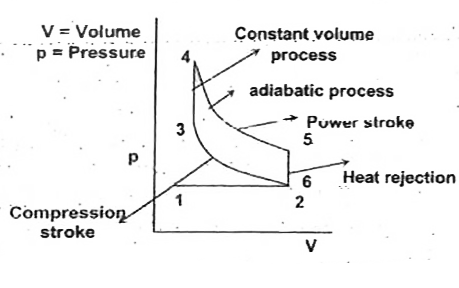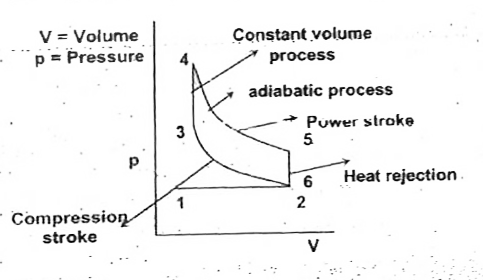Combustion of flat paper is fast and complete and'at the same time combustion of crumbled paper make more smoke. a) List the conditions for the complete combustion. b) Name the gases produced during com- -plete combustion. c) Name the gasés produced during partial combustion. d) How does the partial combustion causes environment pollution?
The correct Answer is:a) The solid fuels must be dry. Should evaporate easily. Should reach the ignition temperature. Sufficient amount of oxygen. b) Carbon dioxide c) Carbon dioxide and carbon monoxide. d) Besides the fuel loss and time loss, the carbon monoxide pro- duced during partial combustion. Which is poisonous and cause environment pollution.
Similar Practice Problems
- Question 1 - Select One
To move an airplane through the air, thrust is generated by some kind of propulsion system. Beginning with the Wright brothers' first flight, many airplanes have used internal combustion engines to turn propellers to generate thrust. Today, most general aviation or private airplanes are powered by internal combustion (IC) engines, much like the engine in your family automobile. When discussing engines, we must consider both the mechanical- operation of the machine and the thermodynamic processes that enable the machine to produce useful work. We consider the thermodynamics of a four-stroke IC engine.

Figure shown represents such a cycle which is used in all Internal combustion engines. The figure shows a p-V diagram of the cycle. Using the engine stage numbering system, we begin at the lower left with Stage 1 being the beginning of the intake stroke of the engine. The pressure is near atmospheric pressure and the gas volume is at a minimum. Between Stage 1 and Stage 2 the piston is pulled out of the cylinder with the intake valve open. The pressure remains constant, and the gas volume increases as fuel/air mixture is drawn into the cylinder through the-intake valve. Stage 2 begins the compression stroke of the engine with the closing of the intake valve. Between Stage 2 and Stage 3, the piston moves back into the cylinder, the gas volume.decreases, and the pressure increases because work is done on the gas by the piston. Stage 3 is the beginning of the combustion of the fuel/air mixture. The combustion occurs very quickly and the volume remains constant. Heat is released during combustion which increases both the temperature and the pressure, according to the equation of slate. Slage 4 begins the power stroke of the engine. Between Stage 4 and Stage 5, the piston is driiven towards the crankshaft, the volume in increased, and the pressure falls as work is done by the gas on the píston. At Stage 5 the exhaust valve is opened and the residual heat in the gas is exchanged with the surroundings. The volume remains constant and the pressure adjusts back to atmospheric conditions. Stage 6 begins the exhaust stroke of the engine during which the piston. moves back into the cylinder, the volume decreases and the pressure remains constant. At the end of the exhaust stroke, conditions have returned to Stage 1 and the process repeats itself. During the cycle, work is done on the gas by the plston between stages 2 and 3. Work is done by the gas on the piston between stages 4 and 5. The difference between the work done by the gas and the work done on the gas is the area enclosed by the cycle curve and is the work produced by the cycle. The work times the rate of the cycle (cycles per second) is equal to the power produced by the engine.
Consider that the above diagram represents an ideal such cycle then choose the incorrect statement fora corresponding real cycle.AThe area of the p-V diagram for the real cycle will be lesser than that for ideal cycle.BThe shape of the p-V diagram for the real cycle will be similar to the corresponding ideal cycle.CThe power produced by the engine for an ideal cycle will be greater than that produced by corresponding real cycle.DThe shape of the p-V diagram for the real cycle will not be similar to the ideal cycle. - Question 1 - Select One
To move an airplane through the air, thrust is generated by some kind of propulsion system. Beginning with the Wright brothers' first flight, many airplanes have used internal combustion engines to turn propellers to generate thrust. Today, most general aviation or private airplanes are powered by internal combustion (IC) engines, much like the engine in your family automobile. When discussing engines, we must consider both the mechanical- operation of the machine and the thermodynamic processes that enable the machine to produce useful work. We consider the thermodynamics of a four-stroke IC engine.

Figure shown represents such a cycle which is used in all Internal combustion engines. The figure shows a p-V diagram of the cycle. Using the engine stage numbering system, we begin at the lower left with Stage 1 being the beginning of the intake stroke of the engine. The pressure is near atmospheric pressure and the gas volume is at a minimum. Between Stage 1 and Stage 2 the piston is pulled out of the cylinder with the intake valve open. The pressure remains constant, and the gas volume increases as fuel/air mixture is drawn into the cylinder through the-intake valve. Stage 2 begins the compression stroke of the engine with the closing of the intake valve. Between Stage 2 and Stage 3, the piston moves back into the cylinder, the gas volume.decreases, and the pressure increases because work is done on the gas by the piston. Stage 3 is the beginning of the combustion of the fuel/air mixture. The combustion occurs very quickly and the volume remains constant. Heat is released during combustion which increases both the temperature and the pressure, according to the equation of slate. Slage 4 begins the power stroke of the engine. Between Stage 4 and Stage 5, the piston is driiven towards the crankshaft, the volume in increased, and the pressure falls as work is done by the gas on the píston. At Stage 5 the exhaust valve is opened and the residual heat in the gas is exchanged with the surroundings. The volume remains constant and the pressure adjusts back to atmospheric conditions. Stage 6 begins the exhaust stroke of the engine during which the piston. moves back into the cylinder, the volume decreases and the pressure remains constant. At the end of the exhaust stroke, conditions have returned to Stage 1 and the process repeats itself. During the cycle, work is done on the gas by the plston between stages 2 and 3. Work is done by the gas on the piston between stages 4 and 5. The difference between the work done by the gas and the work done on the gas is the area enclosed by the cycle curve and is the work produced by the cycle. The work times the rate of the cycle (cycles per second) is equal to the power produced by the engine.
Choose.the correct statement.ADuring the compression stroke, the gas does positive work.BDuring the power stroke the gas.does positive work.CBetween stage 1, 2, the work is done on the gas.DNone of the above. - Question 1 - Select One
Incomplete combustion of coal and petroleum :
(A) increases air pollution.
(B) increases efficiency of machines.
(C) reduces global warming.
(D) produce poisonous gases.
The correct option is :A(A) and (B)B(A) and (D)C(B) and (C)D(C) and (D) - Question 1 - Select One
Incomplete combustion of coal and petroleum :
(A) increases air pollution, (B) increases efficiency of machines.
(C) reduces global warming, (D) produce poisonous gases.
The correct option is :A(A) and (B)B(A) and (D)C(B) and (C)D(C) and (D) - Question 1 - Select One
Fire in Space
On Earth, fire provides light, heat, and comfort. Its creation, by a process called combustion, requires a chemical reaction between a fuel source and oxygen. The shape that fire assumes on Earth is a result of gravitational influence and the movement of molecules. In the microgravity environment of space, 34 moreover––––––––––, combustion and the resulting fire behave in fundamentally different ways than they do on Earth—differences that have important implications for researchers.
A group of engineering students from the University of California at San Diego (UCSD), for example, 35 tried to find a method to make their biofuel combustion study––––––––––––––––––––––––––––––––––––––––––––––––––––––––––––––––––– (fuels derived from once-living material) free of the drawbacks researchers face on Earth. The standard method involves burning droplets of fuel, but Earth’s gravitational influence causes the droplets to lose spherical symmetry while burning. This 36 deformation––––––––––––– results in subtle variations in density that both 37 causes uneven heat flow and limits––––––––––––––––––––––––––––––––––––– the size of the droplets that can be tested. Specially designed “drop towers” 38 built for this purpose––––––––––––––––––––––– reduce these problems, but they provide no more than 10 seconds of microgravity, and droplet size is still too small to produce accurate models of combustion rates. 39 The UCSD students understood that these limitations had to be surmounted–––––––––––––––––––––––––––––––––––––––––––––––––––––––––––––––––––––––––––––––––––. As part of the program, researchers fly their experiments aboard aircraft that simulate the microgravity environment of space. The aircraft accomplish this feat by flying in parabolic paths instead of horizontal ones. On the plane’s ascent, passengers feel twice Earth’s gravitational pull, but for brief periods at the peak of the trajectory, 40 (“weightlessness” or microgravity similar to what is experienced in space)––––––––––––––––––––––––––––––––––––––––––––––––––––––––––––––––––––––––––––––––– , is achieved. These flights allowed the UCSD students to experience microgravity 41 . Specifically, they 42 investigated––––––––––––– the combustion of biofuel droplets in microgravity for twice as long as could be accomplished in drop towers and to perform tests with larger droplets. The larger, 43 spherically symmetric–––––––––––––––––––––––– droplets burned longer and gave the students more reliable data on combustion rates of biofuels because the droplets’ uniform shape reduced the variations in density that hinder tests performed in normal gravity. The students hope the new data will aid future research by improving theoretical models of biofuel combustion. Better combustion-rate models may even lead to the production of more fuel-efficient engines and improved 44 techniques, for fighting fires in space or at future outposts–––––––––––––––––––––––––––––––––––––––––––––––––––––––––––––– on the Moon and Mars.ANO CHANGEBhowever,Caccordingly,Dsubsequently, - Question 1 - Select One
Fire in Space
On Earth, fire provides light, heat, and comfort. Its creation, by a process called combustion, requires a chemical reaction between a fuel source and oxygen. The shape that fire assumes on Earth is a result of gravitational influence and the movement of molecules. In the microgravity environment of space, 34 moreover––––––––––, combustion and the resulting fire behave in fundamentally different ways than they do on Earth—differences that have important implications for researchers.
A group of engineering students from the University of California at San Diego (UCSD), for example, 35 tried to find a method to make their biofuel combustion study––––––––––––––––––––––––––––––––––––––––––––––––––––––––––––––––––– (fuels derived from once-living material) free of the drawbacks researchers face on Earth. The standard method involves burning droplets of fuel, but Earth’s gravitational influence causes the droplets to lose spherical symmetry while burning. This 36 deformation––––––––––––– results in subtle variations in density that both 37 causes uneven heat flow and limits––––––––––––––––––––––––––––––––––––– the size of the droplets that can be tested. Specially designed “drop towers” 38 built for this purpose––––––––––––––––––––––– reduce these problems, but they provide no more than 10 seconds of microgravity, and droplet size is still too small to produce accurate models of combustion rates. 39 The UCSD students understood that these limitations had to be surmounted–––––––––––––––––––––––––––––––––––––––––––––––––––––––––––––––––––––––––––––––––––. As part of the program, researchers fly their experiments aboard aircraft that simulate the microgravity environment of space. The aircraft accomplish this feat by flying in parabolic paths instead of horizontal ones. On the plane’s ascent, passengers feel twice Earth’s gravitational pull, but for brief periods at the peak of the trajectory, 40 (“weightlessness” or microgravity similar to what is experienced in space)––––––––––––––––––––––––––––––––––––––––––––––––––––––––––––––––––––––––––––––––– , is achieved. These flights allowed the UCSD students to experience microgravity 41 . Specifically, they 42 investigated––––––––––––– the combustion of biofuel droplets in microgravity for twice as long as could be accomplished in drop towers and to perform tests with larger droplets. The larger, 43 spherically symmetric–––––––––––––––––––––––– droplets burned longer and gave the students more reliable data on combustion rates of biofuels because the droplets’ uniform shape reduced the variations in density that hinder tests performed in normal gravity. The students hope the new data will aid future research by improving theoretical models of biofuel combustion. Better combustion-rate models may even lead to the production of more fuel-efficient engines and improved 44 techniques, for fighting fires in space or at future outposts–––––––––––––––––––––––––––––––––––––––––––––––––––––––––––––– on the Moon and Mars.
Which choice most effectively establishes that the UCSD students’ approach had solved a problem, mentioned earlier in the passage, relating to burning fuel on Earth?ANO CHANGEBcombustibleCmicrogravity-influencedDbiofuel-derived - Question 1 - Select One
Fire in Space
On Earth, fire provides light, heat, and comfort. Its creation, by a process called combustion, requires a chemical reaction between a fuel source and oxygen. The shape that fire assumes on Earth is a result of gravitational influence and the movement of molecules. In the microgravity environment of space, 34 moreover––––––––––, combustion and the resulting fire behave in fundamentally different ways than they do on Earth—differences that have important implications for researchers.
A group of engineering students from the University of California at San Diego (UCSD), for example, 35 tried to find a method to make their biofuel combustion study––––––––––––––––––––––––––––––––––––––––––––––––––––––––––––––––––– (fuels derived from once-living material) free of the drawbacks researchers face on Earth. The standard method involves burning droplets of fuel, but Earth’s gravitational influence causes the droplets to lose spherical symmetry while burning. This 36 deformation––––––––––––– results in subtle variations in density that both 37 causes uneven heat flow and limits––––––––––––––––––––––––––––––––––––– the size of the droplets that can be tested. Specially designed “drop towers” 38 built for this purpose––––––––––––––––––––––– reduce these problems, but they provide no more than 10 seconds of microgravity, and droplet size is still too small to produce accurate models of combustion rates. 39 The UCSD students understood that these limitations had to be surmounted–––––––––––––––––––––––––––––––––––––––––––––––––––––––––––––––––––––––––––––––––––. As part of the program, researchers fly their experiments aboard aircraft that simulate the microgravity environment of space. The aircraft accomplish this feat by flying in parabolic paths instead of horizontal ones. On the plane’s ascent, passengers feel twice Earth’s gravitational pull, but for brief periods at the peak of the trajectory, 40 (“weightlessness” or microgravity similar to what is experienced in space)––––––––––––––––––––––––––––––––––––––––––––––––––––––––––––––––––––––––––––––––– , is achieved. These flights allowed the UCSD students to experience microgravity 41 . Specifically, they 42 investigated––––––––––––– the combustion of biofuel droplets in microgravity for twice as long as could be accomplished in drop towers and to perform tests with larger droplets. The larger, 43 spherically symmetric–––––––––––––––––––––––– droplets burned longer and gave the students more reliable data on combustion rates of biofuels because the droplets’ uniform shape reduced the variations in density that hinder tests performed in normal gravity. The students hope the new data will aid future research by improving theoretical models of biofuel combustion. Better combustion-rate models may even lead to the production of more fuel-efficient engines and improved 44 techniques, for fighting fires in space or at future outposts–––––––––––––––––––––––––––––––––––––––––––––––––––––––––––––– on the Moon and Mars.
At this point, the writer is considering adding the following.
and perform their experiment without traveling into space Should the writer make this addition here?AYes, because it elaborates on the advantage the students gained from the flights.BYes, because it reveals that the students did not actually go into space, a point that the previous paragraph does not address.CNo, because it shifts focus away from the students’ experiences while on the flights.DNo, because it restates what has already been said in the sentence
Similar Questions
Name the products obtained on complete combustion of hydrocarbons? How is the gas evolved during combustion tested in the laboratory? Explain in brief.
View SolutionA gaseous hydrocarbon consumed 5 times its volume of oxygen as for combustion. The volume of CO2 produced in the reaction is thrice the volume of hydrocarbon under the same conditions
How many grams of water is produced by combustion of 0.1 mol of the givenn hydrocarbon?View SolutionSome words (underlined) in the following sentences are jumbled up. Write them in their correct form.
(a) underline("Seldie") is a combustible substance.
(b) Slags–––––– is a non-combustible material.
(c) Chittsmack––––––––––––– does not burn by itself.
(d) Some substances on combustion produce thea––––– and mafel.–––––––
(e) The amount of heat energy produced on complete combustion of 1 kg of a fuel is called its ficalroic––––––––– value.View Solution

